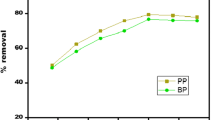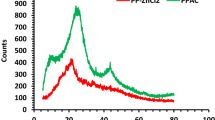Abstract
In this study, the ability of dry Anabasis aphylla as an adsorbent for removing methylene blue (MB) from aqueous solutions was evaluated. The effects of several experimental factors such as, initial MB concentration (10–100 mg L−1), adsorbent dosage (0.10–1.00 g), pH (2–10), and contact time (1–48 h) on MB removal were investigated at room temperature (20 ± 3 °C). Moreover, the experimental data were applied to three kinetic models namely, pseudo-first order, pseudo-second order, and Elovich kinetic models. Furthermore, four common isotherm models namely, Langmuir, Freundlich, Dubinin–Radushkevich (D-R) and Temkin isotherm models were used to understand the adsorption mechanism of MB into dry A. aphylla. In addition, the efficiency of free dry A. aphylla to remove MB from aqueous solutions was compared with immobilized dry A. aphylla. The results reveal that the maximum removal efficiency (63%) of MB was obtained at optimum conditions including 10 mg L−1 initial MB concentration, 0.40 g adsorbent dosage, initial pH of MB solution 4, and 2.0 h contact time. In addition, immobilized dry A. aphylla gives lower removal efficiency of MB (20%). MB removal by dry A. aphylla follows pseudo-second order and it is best fitted by Freundlich isotherm. The results of ATR-FTIR analysis of dry A. aphylla before and after MB adsorption confirm the MB binding with dry A. aphylla through adsorption process.
Graphical Abstract











Similar content being viewed by others
Availability of Data and Materials
The data that support the findings of this study are available from the corresponding author upon reasonable request.
Code Availability
Not applicable.
References
Eltaweil AS, Abdelfatah AM, Hosny M, Fawzy M (2022) Novel biogenic synthesis of a Ag@Biochar nanocomposite as an antimicrobial agent and photocatalyst for methylene blue degradation. ACS Omega 7:8046–8059. https://doi.org/10.1021/acsomega.1c07209
Ugraskan V, Isik B, Yazici O (2022) Adsorptive removal of methylene blue from aqueous solutions by porous boron carbide: isotherm, kinetic and thermodynamic studies. Chem Eng Commun 209:1111–1129. https://doi.org/10.1080/00986445.2021.1948406
Liu XJ, Li MF, Singh SK (2021) Manganese-modified lignin biochar as adsorbent for removal of methylene blue. J Mater Res Technol 12:1434–1445. https://doi.org/10.1016/j.jmrt.2021.03.076
Khan I, Saeed K, Zekker I, Zhang B, Hendi AH, Ahmad A, Ahmad S, Zada N, Ahmad H, Shah LA, Shah T, Khan I (2022) Review on methylene blue: its properties, uses, toxicity and photodegradation. Water 14:1–30
Din MI, Khalid R, Najeeb J, Hussain Z (2021) Fundamentals and photocatalysis of methylene blue dye using various nanocatalytic assemblies—a critical review. J Clean Prod 298:126567. https://doi.org/10.1016/j.jclepro.2021.126567
Kuang Y, Zhang X, Zhou S (2020) Adsorption of methylene blue in water onto activated carbon by surfactant modification. Water (Switzerland) 12:1–19. https://doi.org/10.3390/w12020587
Bulgariu L, Escudero LB, Bello OS, Iqbal M, Nisar J, Adegoke KA, Alakhras F, Kornaros M, Anastopoulos I (2019) The utilization of leaf-based adsorbents for dyes removal: a review. J Mol Liq 276:728–747. https://doi.org/10.1016/j.molliq.2018.12.001
Tan KA, Morad N, Ooi JQ (2016) Phytoremediation of methylene blue and methyl orange using Eichhornia crassipes. Int J Environ Sci Dev 7:724–728. https://doi.org/10.18178/ijesd.2016.7.10.869
Imron MF, Kurniawan SB, Soegianto A, Wahyudianto FE (2019) Phytoremediation of methylene blue using duckweed (Lemna minor). Heliyon 5:e02206. https://doi.org/10.1016/j.heliyon.2019.e02206
Bestani B, Benderdouche N, Benstaali B, Belhakem M, Addou A (2008) Methylene blue and iodine adsorption onto an activated desert plant. Bioresour Technol 99:8441–8444. https://doi.org/10.1016/j.biortech.2008.02.053
Alshekhli AF, Hasan HA, Muhamad MH, Sheikh-Abdullah SR (2020) Development of adsorbent from phytoremediation plant waste for methylene blue removal. J Ecol Eng 21:207–215. https://doi.org/10.12911/22998993/126873
Gupta N, Kushwaha AK, Chattopadhyaya MC (2016) Application of potato (Solanum tuberosum) plant wastes for the removal of methylene blue and malachite green dye from aqueous solution. Arab J Chem 9:S707–S716. https://doi.org/10.1016/j.arabjc.2011.07.021
Hassan W, Farooq U, Ahmad M, Athar M, Khan MA (2017) Potential biosorbent, Haloxylon recurvum plant stems, for the removal of methylene blue dye. Arab J Chem 10:S1512–S1522. https://doi.org/10.1016/j.arabjc.2013.05.002
Zhang L, Tan J, Xing G, Dou X, Guo X (2021) Cotton stalk-derived hydrothermal carbon for methylene blue dye removal: investigation of the raw material plant tissues. Bioresour Bioprocess. https://doi.org/10.1186/s40643-021-00364-8
Al-Baldawi IA, Abdullah SRS, Anuar N, Hasan HA (2018) Phytotransformation of methylene blue from water using aquatic plant (Azolla pinnata). Environ Technol Innov 11:15–22. https://doi.org/10.1016/j.eti.2018.03.009
El-Sayed GO (2011) Removal of methylene blue and crystal violet from aqueous solutions by palm kernel fiber. Desalination 272:225–232. https://doi.org/10.1016/j.desal.2011.01.025
Oladoye PO, Ajiboye TO, Omotola EO, Oyewola OJ (2022) Methylene blue dye: toxicity and potential elimination technology from wastewater. Results Eng 16:100678. https://doi.org/10.1016/j.rineng.2022.100678
Kani AN, Dovi E, Mpatani FM, Li Z, Han R, Qu L (2020) Tiger nut residue as a renewable adsorbent for methylene blue removal from solution: adsorption kinetics, isotherm, and thermodynamic studies. Desalin Water Treat 191:426–437. https://doi.org/10.5004/dwt.2020.25735
Guolan H, Hongwen S, Li CL (2000) Study on the physiology and degradation of dye with immobilized algae. Artif Cells Blood Substit Immobil Biotechnol 28:347–363. https://doi.org/10.3109/10731190009119364
Raj A, Yadav A, Rawat AP, Singh AK, Kumar S, Pandey AK, Sirohi R, Pandey A (2021) Kinetic and thermodynamic investigations of sewage sludge biochar in removal of Remazol Brilliant Blue R dye from aqueous solution and evaluation of residual dyes cytotoxicity. Environ Technol Innov 23:101556. https://doi.org/10.1016/j.eti.2021.101556
Zareh MM, El-Sayed AS, El-Hady DM (2022) Biosorption removal of iron from water by Aspergillus Niger. NPJ Clean Water 58:1–7. https://doi.org/10.1038/s41545-022-00201-1
Samieifard R, Landi A, Pourreza N (2021) Adsorption of Cd Co, and Zn from multi-ionic solutions onto Iranian sepiolite isotherms. Central Asian J Environ Sci Technol Innov 3:102–118. https://doi.org/10.22034/CAJESTI.2021.03.02
Bahrun MHV, Bono A, Zaini MAA, Othman N, Saptoro A (2022) Dynamic performances of adsorbents in an industrial-sized packed bed column for lead ion removal. Biomass Convers Biorefinery. https://doi.org/10.1007/s13399-022-03379-z
Jani NA, Haddad L, Abdulhameed AS, Jawad AH, ALOthman ZA, Yaseen ZM (2022) Modeling and optimization of the adsorptive removal of crystal violet dye by durian (Durio zibethinus) seeds powder: insight into kinetic, isotherm, thermodynamic, and adsorption mechanism. Biomass Convers Biorefinery. https://doi.org/10.1007/s13399-022-03319-x
Mousavi SA, Kamarehie B, Almasi A, Darvishmotevalli M, Salari M, Moradnia M, Azimi F, Ghaderpoori M, Neyazi Z, Karami MA (2021) Removal of Rhodamine B from aqueous solution by stalk corn activated carbon: adsorption and kinetic study. Biomass Convers Biorefinery. https://doi.org/10.1007/s13399-021-01628-1
Taşar Ş (2022) Thermal conversion behavior of cellulose and hemicellulose fractions isolated from tea leaf brewing waste: kinetic and thermodynamic evaluation. Biomass Convers Biorefinery 12:2935–2947. https://doi.org/10.1007/s13399-021-01697-2
Shaltout AA, Allam MA, Moharram MA (2011) FTIR spectroscopic, thermal and XRD characterization of hydroxyapatite from new natural sources. Spectrochim Acta Part A Mol Biomol Spectrosc 83:56–60. https://doi.org/10.1016/j.saa.2011.07.036
Sharma S, Uttam KN (2016) Investigation of the manganese stress on wheat plant by attenuated total reflectance Fourier transform infrared spectroscopy. Spectrosc Lett 49:520–528. https://doi.org/10.1080/00387010.2016.1212897
Salah Omer A, El Naeem GA, Abd-Elhamid AI, Farahat OOM, El-Bardan AA, Soliman HMA, Nayl AA (2022) Adsorption of crystal violet and methylene blue dyes using a cellulose-based adsorbent from sugercane bagasse: characterization, kinetic and isotherm studies. J Mater Res Technol 19:3241–3254. https://doi.org/10.1016/j.jmrt.2022.06.045
Ghosh I, Kar S, Chatterjee T, Bar N, Das SK (2021) Removal of methylene blue from aqueous solution using Lathyrus sativus husk: Adsorption study, MPR and ANN modelling. Process Saf Environ Prot 149:345–361. https://doi.org/10.1016/j.psep.2020.11.003
Ishak Z, Salim S, Kumar D (2021) Adsorption of methylene blue and reactive black 5 by activated carbon derived from tamarind seeds. Trop Aquat Soil Pollut 2:1–12. https://doi.org/10.53623/tasp.v2i1.26
Misran E, Bani O, Situmeang EM, Purba AS (2022) Banana stem based activated carbon as a low-cost adsorbent for methylene blue removal: isotherm, kinetics, and reusability. Alexandria Eng J 61:1946–1955. https://doi.org/10.1016/j.aej.2021.07.022
Zhang W, Lan Y, Ma M, Chai S, Zuo Q, Kim KH, Gao Y (2020) A novel chitosan–vanadium-titanium-magnetite composite as a superior adsorbent for organic dyes in wastewater. Environ Int 142:105798. https://doi.org/10.1016/j.envint.2020.105798
Adusei JK, Agorku ES, Voegborlo RB, Ampong FK, Danu BY, Amarh FA (2022) Removal of Methyl red in aqueous systems using synthesized NaAlg-g-CHIT/nZVI adsorbent. Sci African 17:e01273. https://doi.org/10.1016/j.sciaf.2022.e01273
Mansour AT, Alprol AE, Abualnaja KM, El-Beltagi HS, Ramadan KMA, Ashour M (2022) Dried brown seaweed’s phytoremediation potential for methylene blue dye removal from aquatic environments. Polymers (Basel) 14:1–26. https://doi.org/10.3390/polym14071375
Kocaman S (2020) Removal of methylene blue dye from aqueous solutions by adsorption on levulinic acid-modified natural shells. Int J Phytoremediation 22:885–895. https://doi.org/10.1080/15226514.2020.1736512
Rashid R, Shafiq I, Iqbal MJ, Shabir M, Akhter P, Hamayun MH, Ahmed A, Hussain M (2021) Synergistic effect of NS co-doped TiO2adsorbent for removal of cationic dyes. J Environ Chem Eng 9:105480. https://doi.org/10.1016/j.jece.2021.105480
Iwuozor KO, Emenike EC, Gbadamosi FA, Ighalo JO, Umenweke GC, Iwuchukwu FU, Nwakire CO, Igwegbe CA (2022) Adsorption of organophosphate pesticides from aqueous solution: a review of recent advances. Springer, Berlin
Sintakindi A, Ankamwar B (2022) Biosorption of Bromocresol green from aqueous solution by Earliella scabrosa fungal biomass in removal of environmental pollutants. Int J Environ Sci Technol. https://doi.org/10.1007/s13762-022-04218-4
Abdul Mubarak NS, Bahrudin NN, Jawad AH, Hameed BH, Sabar S (2021) Microwave enhanced synthesis of sulfonated chitosan-montmorillonite for effective removal of methylene blue. J Polym Environ 29:4027–4039. https://doi.org/10.1007/s10924-021-02172-9
Rajabi M, Keihankhadiv S, Suhas TI, Karri RR, Chaudhary M, Mubarak NM, Chaudhary S, Kumar P, Singh P (2022) Comparison and interpretation of isotherm models for the adsorption of dyes, proteins, antibiotics, pesticides and heavy metal ions on different nanomaterials and non-nano materials-a comprehensive review. J Nanostruct Chem 13:43–65. https://doi.org/10.1007/s40097-022-00509-x
Aldemir and Kul (2020) Isotherm, kinetic and thermodynamic studies for the adsorption of methylene blue on almond leaf powder. Cumhur Sci J 41:160–168
Mohanan KDP, Mohan NP, Selvasudha N, Thekkilaveedu S, Kandasamy R (2021) Facile fabrication and structural elucidation of lignin based macromolecular green composites for multifunctional applications. J Appl Polym Sci. https://doi.org/10.1002/app.51280
Radoor S, Karayil J, Jayakumar A, Parameswaranpillai J, Siengchin S (2021) Removal of methylene blue dye from aqueous solution using PDADMAC modified ZSM-5 Zeolite as a novel adsorbent. J Polym Environ 29:3185–3198. https://doi.org/10.1007/s10924-021-02111-8
Al-Ghouti MA, Da’ana DA (2020) Guidelines for the use and interpretation of adsorption isotherm models: a review. J Hazard Mater 393:122383. https://doi.org/10.1016/j.jhazmat.2020.122383
Ponnusami V, Gunasekar V, Srivastava SN (2009) Kinetics of methylene blue removal from aqueous solution using gulmohar (Delonix regia) plant leaf powder: Multivariate regression analysis. J Hazard Mater 169:119–127. https://doi.org/10.1016/j.jhazmat.2009.03.066
Dural MU, Cavas L, Papageorgiou SK, Katsaros FK (2011) Methylene blue adsorption on activated carbon prepared from Posidonia oceanica (L.) dead leaves: kinetics and equilibrium studies. Chem Eng J 168:77–85. https://doi.org/10.1016/j.cej.2010.12.038
Mohammadi A, Hamed Daemi MB (2014) Fast removal of malachite green dye using novel superparamagnetic sodium alginate-coated Fe3O4 nanoparticles. Eff grain boundaries paraconductivity YBCO 69:447–455
Peixoto de Araújo T, Quesada HB, dos Santos DF, da Silva-Fonseca BC, Barbieri JZ, Bergamasco R, de Barros MASD (2022) Acetaminophen removal by calcium alginate/activated hydrochar composite beads: Batch and fixed-bed studies. Int J Biol Macromol 203:553–562
Karaghool HAK, Hashim K, Kot P, Muradov M (2022) Preliminary studies of methylene blue remotion from aqueous solutions by Ocimum basilicum. Environ MDPI 9:3–9. https://doi.org/10.3390/environments9020017
Kaur N, Kaushal J (2022) Screening the six plant species for phytoremediation of synthetic textile dye waste water. Mater Today Proc. https://doi.org/10.1016/j.matpr.2022.08.512
Reema RM, Saravanan P, Kumar MD, Renganathan S (2011) Accumulation of methylene blue dye by growing Lemna minor. Sep Sci Technol 46:1052–1058. https://doi.org/10.1080/01496395.2010.528503
Acknowledgements
The authors are grateful to Al al-Bayt University for financial support.
Funding
Funding from Al al-Bayt University was received for conducting this study.
Author information
Authors and Affiliations
Contributions
AA: conceptualization, methodology, sampling, experiment, validation, formal analysis, investigation, data analysis, writing-original draft, visualization; ATA: methodology, visualization, experiment, formal analysis, and revision the manuscript; MMI: provided support for chemical analysis and revised the manuscript; MM: provided support for chemical analysis; and EE: provided support for chemical analysis. All the authors read and approved the final manuscript.
Corresponding author
Ethics declarations
Conflict of Interest
The authors declare no conflict of interest.
Ethical Approval and Consent to Participate
Not applicable.
Consent for Publication
Not applicable.
Rights and permissions
Springer Nature or its licensor (e.g. a society or other partner) holds exclusive rights to this article under a publishing agreement with the author(s) or other rightsholder(s); author self-archiving of the accepted manuscript version of this article is solely governed by the terms of such publishing agreement and applicable law.
About this article
Cite this article
Al Shra’ah, A., Al-Fawwaz, A.T., Ibrahim, M.M. et al. Evaluation of Dry Anabasis aphylla Performance as Adsorbent for Methylene Blue Removal from Aqueous Solutions: Optimization and Kinetic Studies. Chemistry Africa 7, 1411–1422 (2024). https://doi.org/10.1007/s42250-023-00851-9
Received:
Accepted:
Published:
Issue Date:
DOI: https://doi.org/10.1007/s42250-023-00851-9




